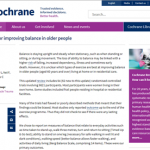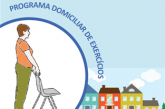This updated review includes 94 randomised controlled trials involving 9821 participants. Most participants were women living in their own home. Some studies included frail people residing in hospital or residential facilities.
Many of the trials had flawed or poorly described methods that meant that their findings could be biased. Most studies only reported on outcomes to the end of the exercise programme. The authors reported on measures of balance as primary outcomes, these related to everyday activities such as:
- Time taken to stand up, walk three metres, turn and return to sitting (Timed Up & Go test)
- Ability to stand on one leg (necessary for safe walking in well lit and dark conditions)
- Walking speed (better balance allows faster walking)
- Activities of daily living (Berg Balance Scale, comprising 14 items)
The authors concluded that there was weak evidence that some exercise types are moderately effective, immediately post intervention, in improving balance in older people. However, methodological issues and missing data means that further research is required.
Access to study findings : Exercise for improving balance in older people



